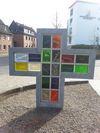

|
|
|
|
|
|
The fallen resistance people in Limburg
Jacques J. de Weert (Zwarte Jacques, Victor)
∗ 10-04-1921 Zundert † 05-09-1944 Kamp Vught (23)
- Aid to People in Hiding L.O. - Nijmegen - Limburg + - Studenten - People in hiding -
- Dr. F. Cammaert, Het verborgen front,
 Hoofdstuk 6a.IV.4., p.532: Falsificaties en inlichtingen
Hoofdstuk 6a.IV.4., p.532: Falsificaties en inlichtingen - J. Rosendaal, Theo Dobbe en de Nijmeegse Knokploeg, in: Jaarboek Numaga 2008, p. 51-77
- Website kamp Vught • Nederlands • Deutsch • English • Français
Nationaal Monument Kamp Vught Monument op de fusilladeplaats
Concentratiekamp Vught, Gedenkboek 36 - Nijmegen: Gedenkplaat voor de in de Tweede Wereldoorlog gevallen leden van de universitaire gemeenschap, voorheen in de hal van de aula aan de Wilhelminasingel, thans in de hal van de aula aan de Comeniuslaan. Zie: Tussen vrijblijvend en bevlogen, p. 19 Zie: Jan Brabers, Proeven van eigen cultuur, dl. 1, p. 278
Arnolds, A.L.M. & al. Gedenkboek 1940-1945 van de katholieke academische gemeenschap, Leiden 1947, p. 98 - Oorlogsgravenstichting.nl
- https://www.oorlogsdodennijmegen.nl/persoon/weert/70f4e621-d993-448c-82ad-30d71933e781
Fred Cammaert wrote in his dissertation [1]:
Already at the beginning of the war, groups were formed that focused on falsifying documents. The L.O. sought support from or received help from some of these groups. J. Hendrikx, for example, formed a forgery group in Venlo in early 1943. F. Halewijn and some associates produced stamps, certificates, and all sorts of other documents. In Nijmegen, as already mentioned, a group headed by J.J. de Weert, a law student, was working, and in The Hague P. van Pesch and J.G. de Groot, who had set up a forgery office there more than a year after leaving Heerlen. De Groot’s office in particular provided invaluable services to the underground in much of the eastern and southern Netherlands. Because of their contacts with the L.O., these groups came into contact with each other during 1943. J. Hendrikx played a leading role in bringing together the various forger groups. De Weert’s group was in financial difficulties, and Hendrikx offered his support on the condition that De Weert would henceforth work for the L.O.. In early 1944 Hendrikx had the Venlo office moved to Nijmegen, and after the arrival of Van Pesch in Nijmegen, the plan to merge the various groups could be realized. A meeting was scheduled for March 30, 1944, at which Hendrikx, De Weert and his close associate M.M. Oosenbrug, as well as the head of the combat group Th. Dobbe were expected. De Weert, however, did not appear. The day before, he and his courier had been arrested in Amsterdam. On September 5, he was shot in Vught. Oosenbrug became his successor and head of the L.O.’s Falsification Headquarters (F.C.-L.O.). The "headquarters" remained in Nijmegen until the summer of 1944, with outposts or distribution points in Zwolle, Eindhoven, and The Hague. In late July or early August, the F.C.-L.O. was moved to Malden, near Nijmegen, where it operated until the liberation of Nijmegen on September 20. After that, other offices in the parts of the country that had not yet been liberated took over the work of the F.C.-L.O.
On the website oorlogsdodennijmegen.nl we read about Jacques de Weert [6]:
Jacques de Weert was a law student at the Roman Catholic University in Nijmegen since 1940. He remained in Nijmegen until the beginning of 1943 and specialized in forging documents of all kinds for the benefit of the underground movement. His underground name was Black Jacques, Victor or Vick. He expanded his forgery group into a national organization and was appointed head of the National Office for Illegal Forgeries of the LO, the National Organization for Persons in Hiding in The Hague. He was arrested on March 29, 1943, and executed in the Vught concentration camp on September 5, 1944. [3]
In the entrance hall of the auditorium of Radboud University in Nijmegen, Jacques de Weert is inscribed on the memorial plaque for members of the university community who have been killed in World War II. [4]
Footnotes

